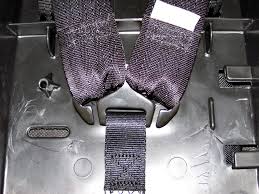Recent Comments
No comments to show.
Posted by admin in Babies 0-6 months, General, How to, Safety on May 26th, 2020
It is important to ensure you are monitoring the ongoing use of your baby capsule or carseat. As your child grows in weight and height it is important to check your baby’s shoulder height in relation to the harness straps of their restraint and, where necessary, make the necessary adjustment to the height of the harness to keep your baby safe. It is really important to ensure that the harness straps are always at or above the shoulder in rearward facing mode as there is potential for significant crash loading to be put on the child’s spine as they ramp ‘up’ the seat in the initial crash phase.
Capsules and carseats have multiple shoulder strap slots so you can move the harness up as your baby grows.
In rearward facing restraints, you should use the slot that is level or slightly above your child’s shoulders. Do not use a slot if it is below your child’s shoulders.
In forward facing restraints, you should use the closest slot to your child’s shoulders, but not more than 25mm below your child’s shoulders.

It is really important to ensure that the harness straps are always at or above the shoulder in rearward facing mode as there is potential for significant crash loading and to be put on the child’s spine as they ramp ‘up’ the seat in the initial crash phase resulting in serious spinal and other injuries.
To adjust the height of your harness, you will need to loosen the harness as much as possible and lay your restraint face down, so that the spreader / G plate becomes visible on the back of the seat. Simply unhook the ends of the harnesses from the spreader / G plate, and re-thread the straps through the appropriate slot for your child’s shoulder height. When you are finished, ensure that you’ve correctly re-attached the straps to the spreader / G plates.
A link to our instructional video demonstrating how to adjust your capsule harness is here and this makes it easy to do:
Some carseats and capsules have a feature that is built into the restraint which adjusts both the headrest and the harness simultaneously. With this feature, there is no need for rethreading or undoing the harness from the spreader / G plate at the back of the seat.
Still need some help with your carseat or capsule harness? Just give us a call on 1300 859 775 option 2 to speak to one of our accredited restraint fitters.
All restraints made under our tough Australian Standard are very effective in the event of an accident – when they’re used properly. Sadly though, many aren’t. A 2009 Monash University study of almost 2000 car journeys involving children in restraint seats found that children had been incorrectly restrained up to 88 per cent of the time, depending on the restraint type; 88 per cent of forward-facing seats were wrongly installed , followed by infant seats (67 per cent) and booster seats (63 per cent). Now that’s a *lot* of children at risk of serious injury or death.
All parents care and love their children, but just buying a seat, even the most expensive seat on the market, then installing it doesn’t provide adequate protection. Its imperative that you know *how* the seat works and how to use it properly.
Following our tips and knowing your car restraints have been installed correctly and you’re confident in using them is the key to safe travel.